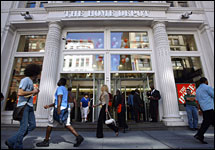MLUI / Articles from 1995 to 2012 / Suburban Retailers Say Hello to Downtown
Suburban Retailers Say Hello to Downtown
Home Depot finds a welcoming market in Manhattan
November 22, 2004 |
Great Lakes Bulletin News Service
 | |
| MLUI | |
Home Depot’s Manhattan store is so popular, so well-designed, and so accessible that it has promise for becoming the new model other retailers will emulate in downtowns. |
Just in time for this holiday shopping season is Home Depot’s trend-setting New York City store on 23rd Street between 5th and 6th Avenues. Even though the store is big enough to fill a six-story, beautifully restored cast iron landmark building, there’s no parking. There is a doorman, however, and home delivery. But what really makes Home Depot’s entrance into the Manhattan market new, and news, is not simply the company’s attention-getting opening in September. It’s also that Home Depot is making a very big statement about the vitality of urban downtowns as new markets for suburban-based developers.
Instead of Macy’s and Hudsons and other historic urban retailers moving out, it’s Home Depot and Wal-Mart and Kmart moving in. Finally, when it comes to the super store wars, the city appears to be gaining.
Downtown's Competitive Edge
For decades American cities have been trying to compete with the suburbs on suburban terms, eroding the urbanism fundamental to any city’s vitality. Stand-alone big boxes surrounded by parking have been permitted by unwitting mayors and city councils, undermining diverse pedestrian retail districts and wiping out valuable streets and historic buildings. Transit-accessible retail streets with apartments above stores (a market form of affordable housing) are replaced by shopping centers with parking in front and little or no transit service. In too many places, inappropriate suburban housing has been built where dense urban row housing and modest apartment houses once thrived.
Some of the worst offenders have been the big box retailers with their inflexible single story, windowless designs foisted on the landscape everywhere. Suburban officials encouraged the trend, often eagerly by doling out tax incentives, property tax abatements, even grants that meant the public paid for new roads and sewers to the stores.
Retail efficiency is said to have gained. Urbanism certainly diminished. The very success that retailers achieved by imposing their formula everywhere has served as a defacto national plan for sprawling development. Urban retailers joined traffic engineers in diminishing America’s urban landscape and turning its suburban one into a place dominated by big boxes, bigger parking lots, and aggravating traffic congestion.
But what those car crazy retailers overlooked is a unique urban phenomenon: Millions of people ride public transit and walk. Urbanites shop on foot, coming from near and far. And now that urban living has become chic again in more places than experts ever anticipated, places like New York, Chicago, Dallas, and San Diego -- those retailers are slowly coming around to discover an emerging shopper’s paradise.
Home Depot calls their new store “Manhattan-Style.” The store is so popular, so well-designed, and so accessible that it has promise for becoming the new model other retailers will emulate in downtowns.
Company Gets It On Urban Retailing
Home Depot’s Manhattan store is housed in the 1878 original Stern Brothers Department Store that eventually became the headquarters for Hasbro, the toy company. The nicely restored white-painted landmark exhibits all the right components of a street smart store – 105,000 square feet in a basement, ground floor and atrium; and interesting windows tailored to the pedestrian. These design components are not dissimilar to what the great retail emporiums of the past put into their stores before suburban malls sucked them off Main Streets everywhere.
Home Depot now is part of a new wave of suburban retailers seeking to colonize New York. Right around the corner on Sixth Avenue — also in the Ladies Mile Historic District — the gracious department store buildings of an earlier era that were saved from demolition by preservationists are filled with vertical superstores. Bed, Bath and Beyond was the first to be persuaded to drop the inward-focused mall formula and retain the traditional storefront. Others followed — Barnes & Noble, Old Navy — all successfully adopting a pedestrian focus. They were never as newsworthy as Home Depot because none of the others were as closely associated with the need for a huge parking lot.
Home Depot, it turned out, didn’t need the parking lot. They recognized what New York’s own Macy’s, Bloomingdale’s, Sak’s Fifth Avenue, and Lord & Taylors never lost sight of — shopping appetites of passing pedestrians, thousands of them. Suburban retailers that migrate to the city learn quickly enough that they have more customers within a 10-minute walk than they are used to having within a 10 mile drive.
For their own sake, superstores and national chains recognize with increasing clarity that to compete, they must go downtown. The suburbs have too many stores, a new trend that retailers call “over-stored.” Retail giants are knocking each other off left and right, or merging (Kmart just bought Sears) to stay alive in oversaturated suburban markets. Beleaguered suburbs are now being left with empty super stores that blight their economic competitiveness, just like what happened in the nation’s cities.
Superstores, for their part, are just learning the art of urban retailing. The flair and character of selling in a city — attractive, eye-catching window displays are a big help — are alien to superstore culture. But superstore executives are getting it. This bodes well for strengthening the personality of America’s places. Big, efficient, appealing, and competitive stores can be designed to benefit rather than diminish neighborhoods.
Roberta Brandes Gratz is an urban critic and author of Cities Back From the Edge: New Life for Downtown, and The Living City: Thinking Small In a Big Way. Reach her at LIVINGCITY@aol.com.





